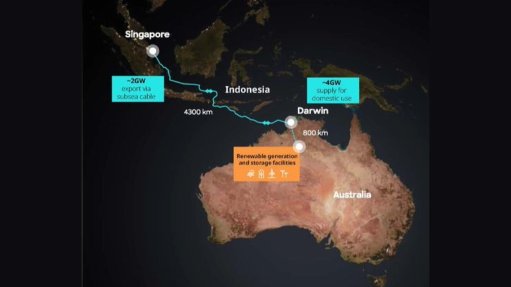Sappi remains resilient despite challenging market conditions
In response to challenging market conditions, largely the result of the Covid-19 pandemic, paper and pulp company Sappi focused on the preservation of liquidity, lowering costs and reprioritising various strategic actions.
Reporting on its results for the financial year ended September 30, Sappi says commercial downtime of 1.1-million tons was taken across all segments as required during the year, in order to match supply to demand and prevent the build-up of inventory.
However, the company lamented on November 5 that this had “major repercussions” for operating efficiency, fixed-cost absorption and profitability.
Additionally, noncritical capital expenditure (capex) projects were deferred and some yearly maintenance shutdowns were postponed for a short period. The project to expand the Saiccor Mill’s capacity was also put on hold through the initial months of the Covid-19 outbreak, but the project is currently 75% complete.
Completion is expected in the third quarter of the 2021 financial year.
With regard to the financial results for the full year, CEO Steve Binnie said the strong growth in sales and profitability for the packaging and specialties segment was “the positive highlight” for the year, as the segment had “proven to be resilient through the Covid-19 crisis and in difficult economic circumstances”.
Graphic paper use, however, declined significantly globally in line with pandemic-related slowdowns in economic activity.
“We believe demand is unlikely to return to pre-Covid-19 levels,” Binnie said. The company responded to this by reducing capacity at two mills.
Lower dissolving pulp (DP) levels, owing to Covid-19, exacerbated an already tough operating environment for the segment, as historical low pricing levels persisted throughout the year. Demand and pricing, however, began to recover in the fourth quarter of the year.
The improvement is evidenced by the quarter-on-quarter improvement in earnings before interest, taxes, depreciation and amortisation (Ebitda) from $26-million to $82-million.
FINANCIAL SUMMARY
Ebitda, excluding special items, for the year was $378-million, down from 2019’s $687-million, while Sappi reported a loss for the year of about $135-million, compared with a $211-million profit in 2019.
Sappi reported a loss a share, excluding special items, of $0.05.
For the fourth quarter, packaging and specialities volumes and profitability increased compared with the prior year’s fourth quarter as the US business, in particular, experienced encouraging sales growth across all of the major product categories, offsetting a slightly weaker performance from the European business, which was affected by the temporary shut of Alfeld PM3 following the fire at that machine in the previous quarter and softer demand for non-essential consumer products.
The South African containerboard business also achieved a strong end to the year.
Industry demand for DP recovered faster than expected as global clothing retail sales rebounded and supply chain inventory levels, which had been allowed to run down, were refilled.
Sappi said that, in response to lower demand, it temporarily shut the calcium line at Saiccor and switched some capacity at Cloquet to paper pulp. As a consequence, DP volumes were 29% lower than the prior year.
Graphic paper demand in Europe and North America was most affected by Covid-19 over the May/June period, and since then, the company has experienced a slow recovery through to September, with volumes 32% lower year-on-year.
Downtime of 321 000 t was taken in the fourth quarter, less than that required in the prior quarter, helping to improve profitability.
Export markets, many of which were impacted later by Covid-19, were particularly weak, and South African newsprint and uncoated woodfree demand continues to be impacted by the weaker domestic economy.
Special items for the quarter reflected an expense of $39-million, which related mainly to asset impairments owing to weaker market conditions and restructuring provisions including the machine closures at Stockstadt and Westbrook mills.
Net cash generated for the quarter was $88-million, compared with $173-million in the fourth quarter last year. The decrease was as a result of reduced profitability and restructuring costs, offset somewhat by lower capex.
Capex of $95-million related mainly to the expansion of DP capacity at Saiccor Mill.
OUTLOOK
Underlying demand for most packaging and speciality products remains robust, driven by consumer preference and the shift from plastic to paper.
Heading in to the 2021 financial year, Sappi anticipates that first-quarter sales volumes will be impacted in both Europe and South Africa by usual seasonal weakness and exacerbated by both the Ngodwana Mill’s yearly maintenance shutdown, which was delayed from the third quarter of the 2020 financial year, and the scheduled Somerset Mill yearly maintenance shut.
These shuts will have an estimated $30-million impact on profitability, predominantly linked to the packaging segment.
Some products remain affected by weaker economic activity in certain regions or end-use markets impacted by Covid-19.
Market conditions for DP have improved and pricing has recovered during October.
At the time of Sappi’s report, published on November 5, the Chinese market price has risen to $680/t, driven by an acceleration in DP demand, a tighter market balance and higher viscose staple fibre prices.
However, in the short term, the combination of the mill maintenance shut at Ngodwana Mill, constrained production on the calcium line at Saiccor Mill owing to the closure of the Lignotech joint venture, and DP pricing which still favours own consumption paper pulp production at Cloquet Mill, will mean that DP sales volumes in the first quarter will be only marginally higher than in the preceding quarter, Sappi explained.
Port and rail challenges in South Africa may additionally impact sales volumes for the quarter, and the company is therefore evaluating opportunities to recover some of the lost DP production prior to the completion of the Saiccor Mill expansion project.
Graphic paper demand continues to improve, and a series of paper machine and mill closures or conversions in the industry recently completed or imminent should improve operating rates in the coming quarter and year.
However, a second wave of Covid-19 infections in Europe is leading to stricter lockdowns and a slowing of the recovery in many countries. Pricing is expected to move in line with variable cost movements.
Current liquidity headroom in the group remains good, with cash deposits at the end of the quarter of $279-million and committed revolving credit facilities of about $582-million.
“We negotiated an extension of our credit facility covenant waiver suspension period until September 2021. The first measurement of these covenants will now take place at the end of December 2021,” Sappi said in its statement.
Capex for the 2021 financial year is estimated to be $370-million and includes about $100-million related to the decision to delay the Saiccor Mill expansion project and the postponement of major shuts at Saiccor and Ngodwana Mills which reduced capital expenditure in the year under review.
In the first quarter of the 2021 financial year, the underlying performance of the business will continue to improve, barring a widespread Covid-19 second wave, driven by the current recovery in DP and graphic paper markets, said Sappi.
However, it warned that this would be offset by the impact on the packaging and specialty segment of the delayed shut at Ngodwana Mill and the scheduled yearly maintenance shut at Somerset Mill.
As a result, Ebitda for the first quarter of 2021 is expected to be slightly below that of the fourth quarter of 2020.
Comments
Press Office
Announcements
What's On
Subscribe to improve your user experience...
Option 1 (equivalent of R125 a month):
Receive a weekly copy of Creamer Media's Engineering News & Mining Weekly magazine
(print copy for those in South Africa and e-magazine for those outside of South Africa)
Receive daily email newsletters
Access to full search results
Access archive of magazine back copies
Access to Projects in Progress
Access to ONE Research Report of your choice in PDF format
Option 2 (equivalent of R375 a month):
All benefits from Option 1
PLUS
Access to Creamer Media's Research Channel Africa for ALL Research Reports, in PDF format, on various industrial and mining sectors
including Electricity; Water; Energy Transition; Hydrogen; Roads, Rail and Ports; Coal; Gold; Platinum; Battery Metals; etc.
Already a subscriber?
Forgotten your password?
Receive weekly copy of Creamer Media's Engineering News & Mining Weekly magazine (print copy for those in South Africa and e-magazine for those outside of South Africa)
➕
Recieve daily email newsletters
➕
Access to full search results
➕
Access archive of magazine back copies
➕
Access to Projects in Progress
➕
Access to ONE Research Report of your choice in PDF format
RESEARCH CHANNEL AFRICA
R4500 (equivalent of R375 a month)
SUBSCRIBEAll benefits from Option 1
➕
Access to Creamer Media's Research Channel Africa for ALL Research Reports on various industrial and mining sectors, in PDF format, including on:
Electricity
➕
Water
➕
Energy Transition
➕
Hydrogen
➕
Roads, Rail and Ports
➕
Coal
➕
Gold
➕
Platinum
➕
Battery Metals
➕
etc.
Receive all benefits from Option 1 or Option 2 delivered to numerous people at your company
➕
Multiple User names and Passwords for simultaneous log-ins
➕
Intranet integration access to all in your organisation

















